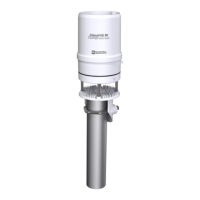bottom plate help dissipate the rainwater to minimize splashing and reduce the likelihood that
the wind measurements are interrupted. Additionally, porous polyethylene membranes protect
the ultrasonic transducers from direct splashing and the sintered (porous) glass construction
draws water from the upper surface of the acoustic mirror to keep a constant sound path length.
Despite these features, heavy rain and strong winds can cause water to reach the membranes and
also cause temporary water buildup on the acoustic mirror. The hydrophobic nature of the
transducer protective membranes and the quick-draining ability of the acoustic mirror should
limit wind measurement interruptions to heavy rain and should bring wind measurement back
online soon after extreme conditions abate.
8.4 Correcting pressure to sea level
The weather service, most airports, radio stations, and television stations adjust the atmospheric
pressure to a common reference (sea level). Eq. 1 (p. 26) can be used to find the difference in
pressure between the sea level and the site in kPa. That value (dP) is then added to the absolute
pressure measurement returned by the ClimaVUE 50 as seen in the example program. Once that
is done, the program shows the pressure conversion to hPa. U. S. Standard Atmosphere and dry
air were assumed when Eq. 1 (p. 26) was derived (Wallace, J. M. and P. V. Hobbes, 1977:
Atmospheric Science: An Introductory Survey, Academic Press, pp. 59-61).
Eq. 1
The value dP is in kPa and the site elevation, E, is in meters. Add dP value to the offset in the
measurement instruction.
Use Eq. 2 (p. 26) to convert feet to meters.
Eq. 2
The corrections involved can be significant. For example, at 100 kPa and 20°C, barometric
pressure will decrease by 0.11kPa for every 10m increase in altitude.
8.5 Effects of bird spike kit on solar radiation
data
With the bird spike kit installed, dips in the pyranometer data may occur during clear sky
conditions. This is caused by the wire shadows that move across the pyranometer sensor
throughout the day on sunny days. The wire shadow effects are negligible (<1% error) on a
ClimaVUE 50 Compact Digital Weather Sensor 26

